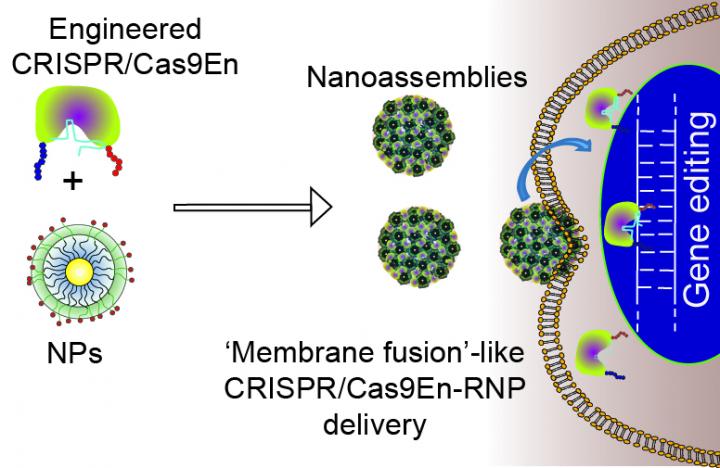



Business Inquiry
Global:
Email:marketing@medicilon.com
+1(781)535-1428(U.S.)
0044 7790 816 954 (Europe)
China:
Email: marketing@medicilon.com.cn
Tel: +86 (21) 5859-1500



Neither the cell membrane nor the cytoplasm nor the nuclear membrane stays these couriers from the swift completion of their appointed rounds. “These couriers” are nanoparticles that carry Cas9-ribonucleoprotein (RNP) complexes into the cytoplasm and nucleus of target cells, and do so with uncommon efficiency.

Newly developed by scientists in Vincent Rotello’s laboratory at the University of Massachusetts, Amherst, the nanoparticles are significant because they could enhance the effectiveness of the already powerful CRISPR/Cas9 gene-editing tool, which holds enormous promise for treating genetic diseases such as cystic fibrosis, muscular dystrophy, and hemophilia. To work well, however, CRISPR/Cas9 must be delivered safely across the cell membrane and into its nucleus, a difficult process that can trigger the cell’s defenses. These defenses can “trap” CRISPR/Cas9, greatly reducing its treatment potential.
Details about the new delivery system recently appeared in the journal ACS Nano, in an article entitled, “Direct Cytosolic Delivery of CRISPR/Cas9-Ribonucleoprotein for Efficient Gene Editing.” The article describes how the new delivery method depends on an engineered version of the Cas9 protein, named Cas9En, and carrier nanoparticles that have been designed to be compatible with CasEn.
“Here, we report a remarkably highly efficient (∼90%) direct cytoplasmic/nuclear delivery of Cas9 protein complexed with a [single] guide RNA (sgRNA) through the coengineering of Cas9 protein and carrier nanoparticles,” wrote the article’s authors. “This construct provides effective (∼30%) gene editing efficiency and opens up opportunities in studying genome dynamics.”
The Rotello laboratory’s experiment leader, Rubul Mout, Ph.D., pointed out that since CRISPR’s potential was first discovered in 2012, gene editing or genome engineering has quickly become an intense research topic in biology and medicine. The goal is to treat otherwise incurable genetic diseases by manipulating diseased genes. “However, to achieve this,” noted Dr. Mout, “biotech and pharmaceutical companies are constantly searching for more efficient CRISPR delivery methods.”
“CRISPR has two components: a scissor-like protein called Cas9, and an RNA molecule called sgRNA that guides Cas9 to its target gene,” he explained. “Once the Cas9-sgRNA pair gets to the destination gene in the nucleus, it can interrogate its genetic mistakes and correct them with the help of the host cell’s repair machinery.”
But the direct and efficient delivery of Cas9-RNP into the cytosol followed by translocation to the nucleus has remained a challenge.
“By finely tuning the interactions between engineered Cas9En protein and nanoparticles, we were able to construct these delivery vectors,” said Dr. Mout. “The vectors carrying the Cas9 protein and sgRNA come into contact with the cell membrane, fuse, and release the Cas9-sgRNA directly into the cell cytoplasm.
“Cas9 protein also has a nuclear guiding sequence that ushers the complex into the destination nucleus. The key is to tweak the Cas9 protein,” he continued. “We have delivered this Cas9 protein and sgRNA pair into the cell nucleus without getting it trapped on its way. We have watched the delivery process live in real time using sophisticated microscopy.”
90% cytosolic/nuclear delivery is a huge improvement compared to others methods, the researchers pointed out. The researchers also indicated that the Cas9En they developed may also serve as a platform for delivery of a variety of other materials such as polymers, lipid nanoparticles, or self-assembling peptides.
“Now that we have achieved efficient gene editing in cultured cells, we are aiming to edit genes in pre-clinical animal models,” Vincent Rotello, Ph.D., remarked. “We are also interested in gene editing for adoptive therapies, where a diseased cell is isolated from a patient, corrected by CRISPR in the lab, and delivered back to the patient.”
Apart from gene editing, the new delivery method may have other uses. For example, another important issue in biology and medicine is tracking DNA and RNA inside cells. Recently, CRISPR has been used to aid in this research. Moumita Ray, Ph.D., another researcher in the Rotello laboratory, added, “Our method allows the precise monitoring of Cas9 protein movement inside a cell, opening new opportunities in genomic research.”
 Relevant
news
Relevant
news